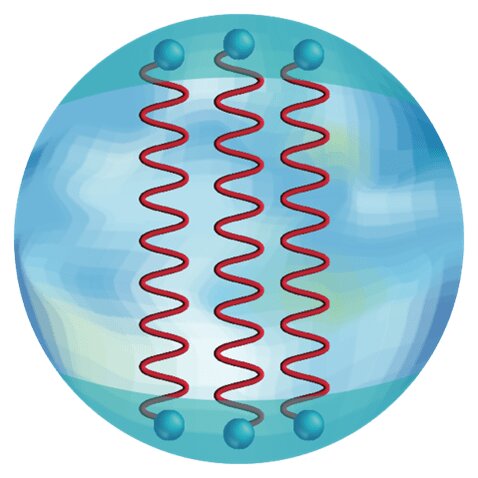Understanding the behavior of nuclear matter—including the quarks and gluons that make up the protons and neutrons of atomic nuclei—is extremely complicated. This is particularly true in our world, which is three dimensional. Mathematical techniques from condensed matter physics that consider interactions in just one spatial dimension (plus time) greatly simplify the challenge.
Using this two-dimensional approach, scientists solved the complex equations that describe how low-energy excitations ripple through a system of dense nuclear matter. This work indicates that the center of neutron stars, where such dense nuclear matter exists in nature, may be described by an unexpected form.
Being able to understand the quark interactions in two dimensions opens a new window into understanding neutron stars, the densest form of matter in the universe. The approach could help advance the current “golden age” for studying these exotic stars. This surge in research success was triggered by recent discoveries of gravitational waves and electromagnetic emissions in the cosmos.
This work shows that for low-energy excitations, all of the complications of the three-dimensional quark interactions fall away. These low-energy excitations are slight disturbances triggered as a neutron star emits radiation or by its own spinning magnetic fields. This approach might also enable new comparisons with quark interactions in less dense but much hotter nuclear matter generated in heavy-ion collisions.
The modern theory of nuclei, known as quantum chromodynamics, involves quarks bound by the strong nuclear force. This force, carried by gluons, confines quarks into nucleons (protons and neutrons).
When the density of nuclear matter increases, as it does inside neutron stars, the dense system behaves more like a mass of quarks, without sharp boundaries between individual nucleons. In this state, quarks at the edge of the system are still confined by the strong force, as quarks on one side of the spherical system interact strongly with quarks on the opposite side.
This work by researchers at Brookhaven National Laboratory uses the one-dimensional nature of this strong interaction, plus the dimension of time, to solve for the behavior of excitations with low energy near the edge of the system. These low energy modes are just like those of a free, massless boson—which is known in condensed matter as a “Luttinger liquid.”
This method allows scientists to compute the parameters of a Luttinger liquid at any given density. It will advance their ability to explore qualitatively new phenomena expected to occur at the extreme densities within neutron stars, where nuclear matter behaves quite differently than it does in ordinary nuclei, and compare it with much hotter (trillion-degree) dense nuclear matter generated in heavy-ion collisions.
The work is published in the journal Physical Review D.
More information:
Marton Lajer et al, When cold, dense quarks in 1+1 and 3+1 dimensions are not a Fermi liquid, Physical Review D (2022). DOI: 10.1103/PhysRevD.105.054035
Citation:
A simple solution for nuclear matter in two dimensions (2023, June 5)
retrieved 6 June 2023
from https://phys.org/news/2023-06-simple-solution-nuclear-dimensions.html
This document is subject to copyright. Apart from any fair dealing for the purpose of private study or research, no
part may be reproduced without the written permission. The content is provided for information purposes only.
Denial of responsibility! TechCodex is an automatic aggregator of the all world’s media. In each content, the hyperlink to the primary source is specified. All trademarks belong to their rightful owners, and all materials to their authors. For any complaint, please reach us at – [email protected]. We will take necessory action within 24 hours.

Jessica Irvine is a tech enthusiast specializing in gadgets. From smart home devices to cutting-edge electronics, Jessica explores the world of consumer tech, offering readers comprehensive reviews, hands-on experiences, and expert insights into the coolest and most innovative gadgets on the market.


